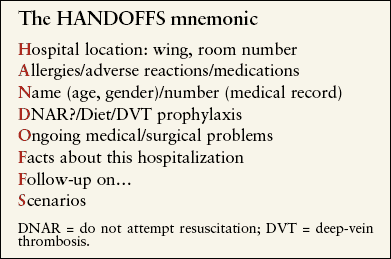Yes, handoffs occur in football. But they also occur in healthcare, when one professional transfers the responsibility for caring for a patient to another provider.
Here is how The Doctor’s Company explains handoffs when talking about hospitalists:
The primary objective of a handoff is to provide accurate information about a patient’s care, treatment, current condition, and any recent or anticipated changes. Handoffs are interactive communications allowing the opportunity for questioning between the provider and the recipient of patient information. For hospitals, the handoffs that occur during the time when a patient is moved to another unit, sent for a diagnostic test, or transferred to a new physician can create continuity of care issues.
The Company has these recommendations for hand-offs:
- Use standardized communication tools such as the mnemonic “HANDOFFS.”
- Allow interactive communication for questions/discussion and require repeat-back of the exchanged information.
- At a minimum, include the following during handoffs: diagnoses, current condition, recent changes in condition or treatment, anticipated changes, and warning signs of changes in the patient’s condition.
- Limit interruptions during handoffs.
- Use the following questions for guidance in organizing communication during the handoff:
- – What is important to communicate?
- – Who needs to know what information?
- – When should communication occur?
- – How should the information be transmitted?
- – How can I validate the communication was successful?
The HANDSOFFS mnemonic is taken from an article titled "The Art of HANDOFFS: A Mnemonic for Teaching the Safe Transfer of Critical Patient Information." The article was written by Alice Brownstein, MD and Anneliese Schleyer, MD, MHA. The article explains the need for good communication during a hand-off:
With the advent of mandatory work-hour restrictions for residents1 and the development of hospitalist programs, patients are often cared for by several physicians during a 24-hour period. In 2004, an estimated 34.9 million people were discharged from hospitals in the United States, with an average length of stay of 4.8 days. Assuming that the care of each patient was handed off twice a day, a minimum of 335 million patient handoffs occurred.
With each handoff, there is an incremental increased risk for errors, near-misses, and challenges to high-quality care. The covering physicians are less aware of the patient’s history, thus slowing the evaluation of new developments. This often leads to unnecessary testing and diagnostic procedures. The primary physician is informed of events after they have occurred and does not have direct involvement in the decision-making.
Frequent handoffs may cause communication breakdowns, with a resulting delay in care. It is often difficult for consultants to communicate directly with the primary physician, since that physician is no longer in the hospital. The impact of multiple transfers of care on patient satisfaction is unknown, but it is reasonable to postulate that it makes it more difficult for patients to identify their primary doctor.
To ensure continuous, seamless care throughout a patient’s hospitalization, it is standard practice for one physician to hand off care to another physician by providing information about the patient. To minimize potential errors from multiple handoffs, a standard set of critical information must be developed and taught to house staff; providing unambiguous instructions for potential adverse events has been shown to decrease the potential for error. [Footnotes omitted.]
Here is the mnemonic:

The article concludes with a vignette that shows how the mnemonic works and with these thoughts from the authors:
It is the experience of the authors that handoffs can be difficult. There are many potential pitfalls, including providing too much information or omitting salient points on the handoff sheet. It is also challenging to learn how to prioritize multiple calls when caring for patients you did not admit. Giving and receiving handoffs takes practice, and to our knowledge there has been little formal investigation about how to best hone this skill. It is our hope that the mnemonic HANDOFFS will help standardize the patient information shared between physicians. It is our belief that learning the fine art of handoffs early in a physician’s career, and continuing to refine this skill, will promote a high quality of care and encourage patient advocacy.
Fascinating stuff. This is very good material to have in our deposition toolbox.
 Day on Torts
Day on Torts

